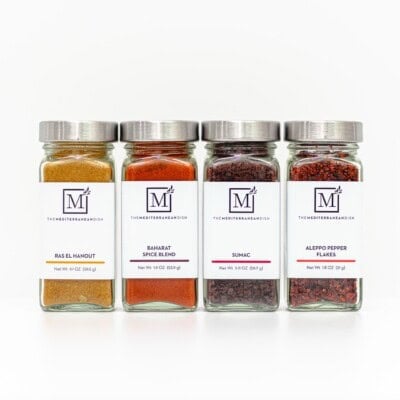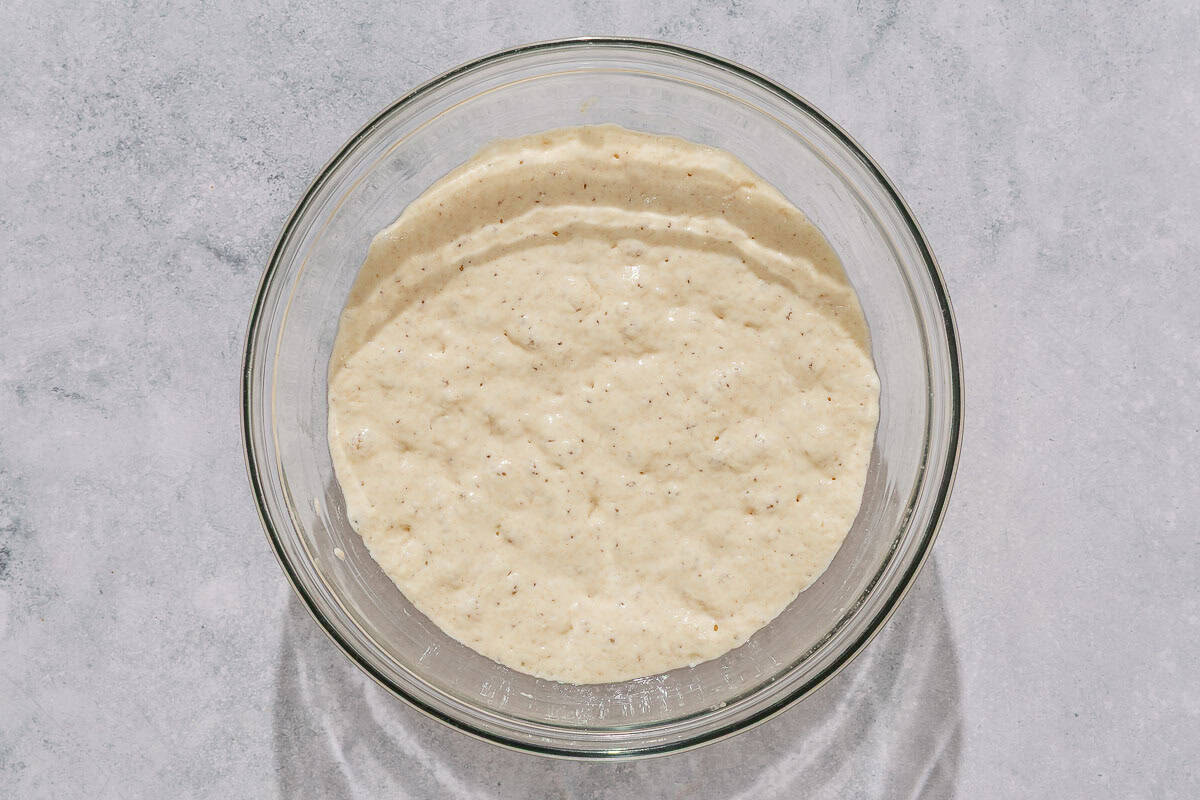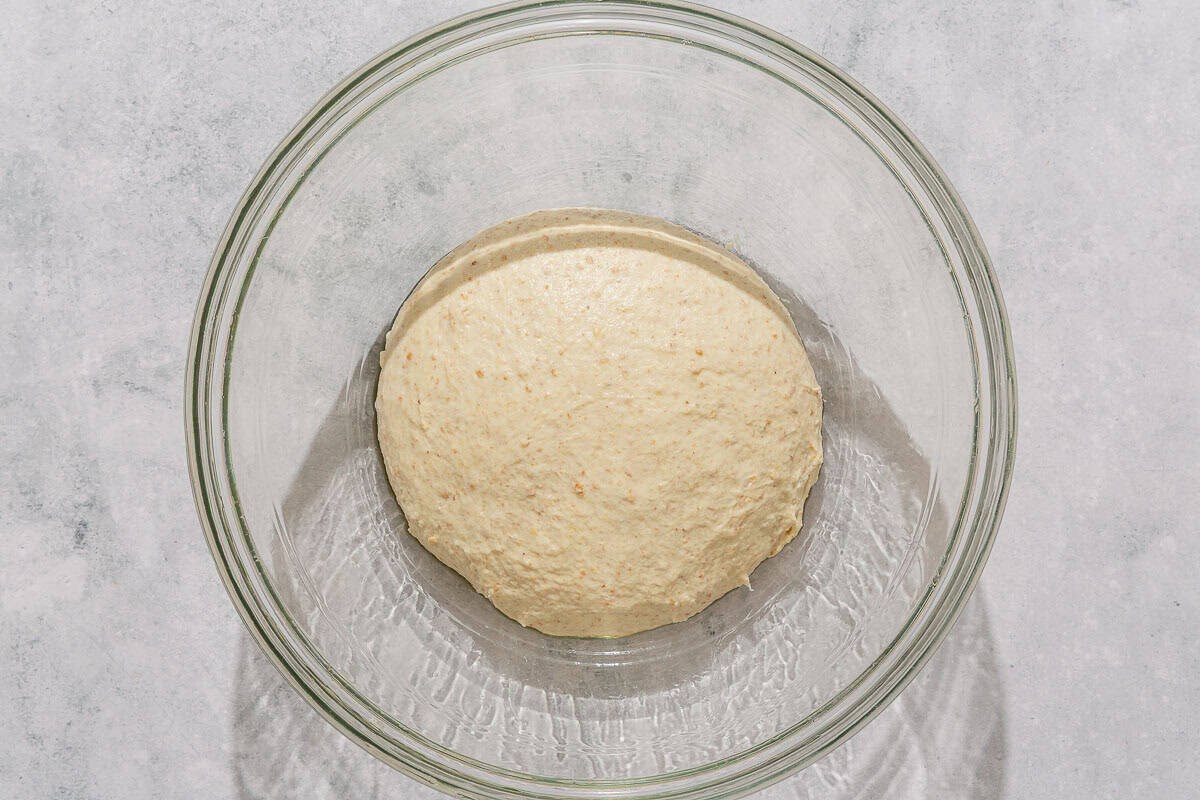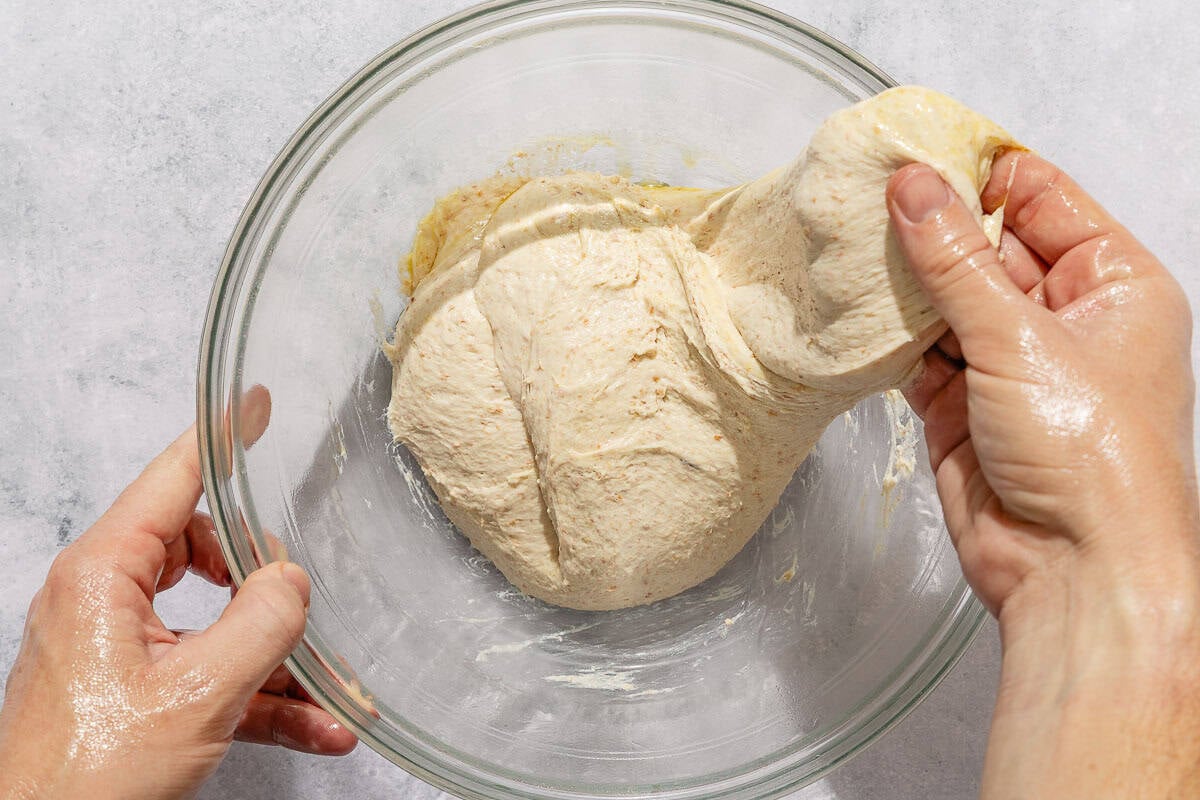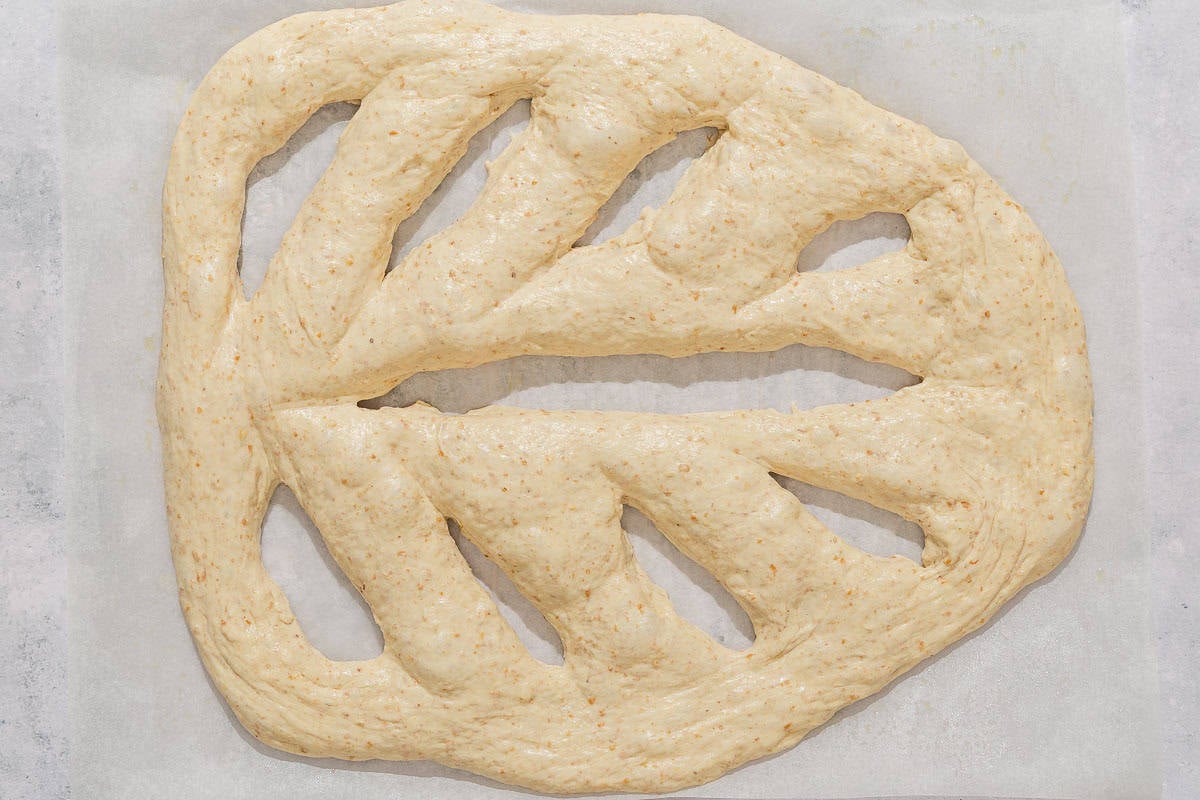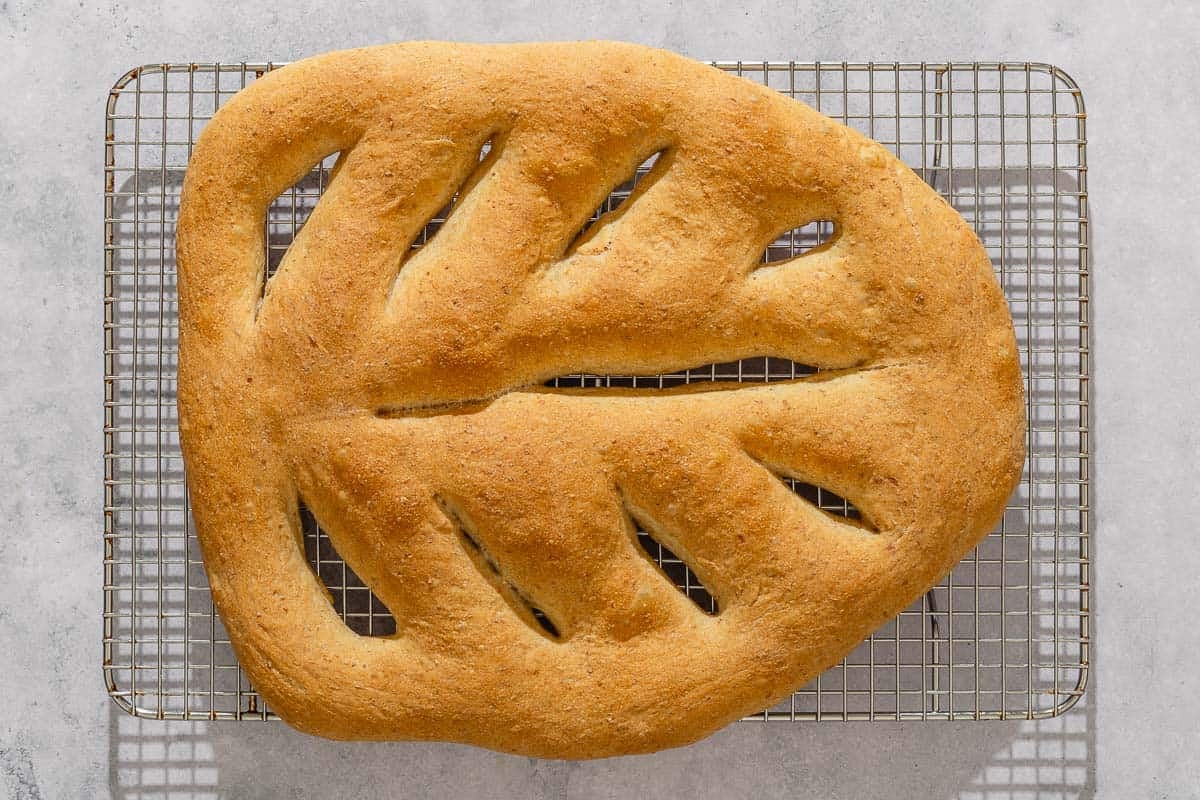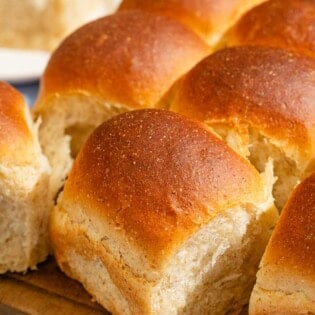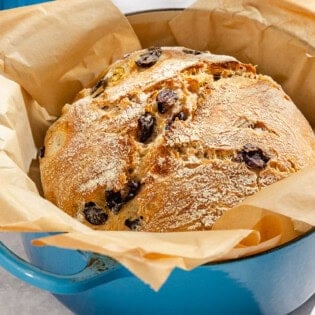Fougasse is a beautifully rustic French bread with a light, open crumb and a crisp crust. This beginner-friendly fougasse recipe uses an overnight ferment to give the bread rich flavor and some of the health benefits of sourdough.

Fougasse (pronounced foo-gahs) bread is a rustic loaf from Provence, France. It’s typically shaped and slashed in a pattern to resemble a head of wheat, but its distinctive cuts aren’t just decorative.
They increase the crust-to-crumb ratio, creating more crisp, chewy edges that make homemade bread so satisfying. Inside, the crumb stays tender and fluffy, making it ideal for tearing apart by hand and dunking into olive oil or a Creamy Mushroom Soup.
If its name resembles focaccia, it’s because both fougasse and focaccia descend from an ancient Roman bread called panis focacius. The name roughly translates to “hearth bread,” as bakers historically baked it in the ashes of a wood-fired oven to test the temperature before loading the day’s loaves. Today, fougasse is served as a side to heartier fare, with an aperitif, or even as a main course with a side salad.
Fougasse may look intimidating, but making it is easier than it seems. I’ve learned over many batches that even when you think you’ve messed up the shape, it still bakes into a loaf with rustic charm. Try it and you’ll be hooked.
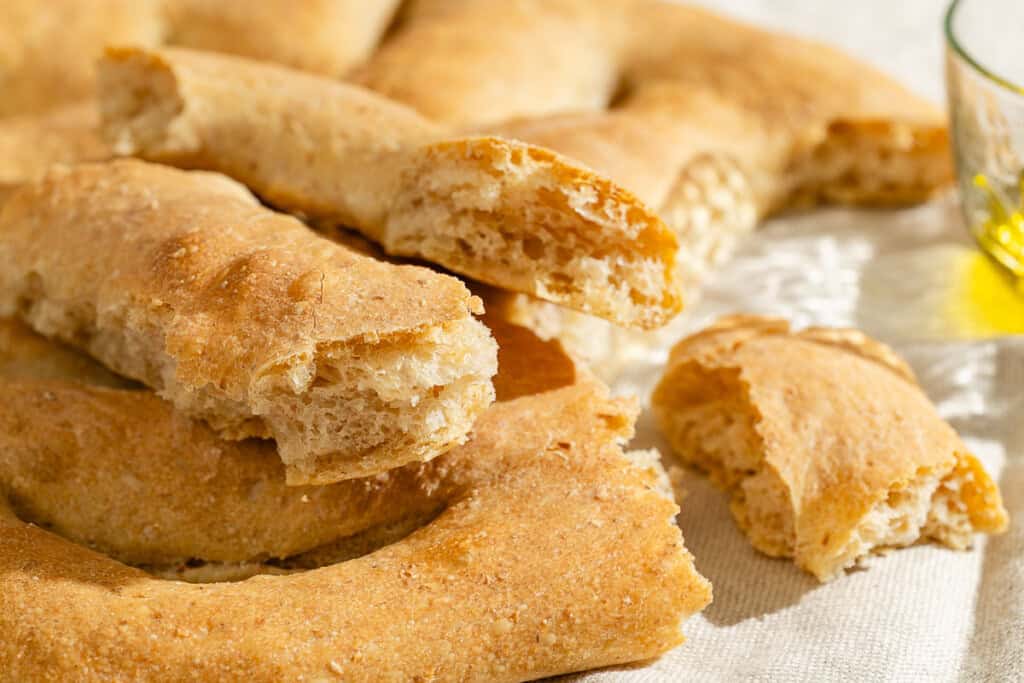
Fougasse Ingredients
I’m always amazed at the array of breads you can make from just flour, yeast, salt, and water. Extra virgin olive oil adds additional flavor and a soft crumb. Here’s everything you’ll need:
- Bread flour has a higher protein content, which provides a better structure and gives the fougasse a nice chew.
- Whole wheat flour: While white flour is typical, adding some whole wheat flour adds a more complex, heartier flavor, and some of the health benefits of whole grains.
- Instant yeast: I’m a fan of instant yeast because it skips the extra step of activating the yeast. If you have active dry yeast on hand, you can substitute that instead. More on this below.
- Extra virgin olive oil adds richness and a fluffy texture to the dough. I like a fruity and mild olive oil in this bread, such as Arbequina.
- Salt enhances the flavor of the bread. I typically use kosher salt, even for baking. If you’re using sea salt or table salt, reduce the amount to 3/4 teaspoon.
How to Make Fougasse
Fougasse does require a bit of time, but the extended fermentation time translates to a more flavorful bread. Start by mixing the poolish the night before you plan to bake and serve the fougasse. Here’s how to make it:
The day before baking:
- Make the poolish: In a medium bowl, combine 1 cup (120g) bread flour, 1/8 teaspoon instant yeast, and 1/2 cup (120ml) water. Cover the bowl and let it sit at room temperature overnight, or 12 to 16 hours. The poolish will be bubbly and should have at least doubled in size.
The next day:
- Make the dough: In the bowl of a stand mixer fitted with the dough hook, combine the poolish, 1 1/2 cups (180g) bread flour, 1/2 cup (57g) whole wheat flour, 1/2 cup (120ml) water, 1 teaspoon instant yeast, 1 tablespoon extra virgin olive oil, and 1 teaspoon kosher salt. Mix on low speed until no dry streaks remain. Then, knead on medium (speed 2 on a KitchenAid mixer) for 5 minutes, until elastic and smooth.
- First rise: Shape the dough into a taut ball. Grease a clean bowl lightly and place the dough in the bowl seam-side down. Cover and leave it in a warm spot to rise for 1 hour.
- Lift and fold the dough: Wet your hands to prevent the dough from sticking. Grab a portion of dough. Gently stretch it upwards, and fold it over the center. Rotate the bowl 90 degrees and repeat until you’ve completed 4 folds. Flip the dough so the seam side is down. Cover and leave it in a warm spot to rise for 1 hour longer.
- Shape the dough: Place a 14 x 16-inch piece of parchment paper on a work surface. Lightly grease it with olive oil. Turn the dough out onto it and shape it into egg-shape about 12 inches long by 6 inches wide at the base. Let it rise for 30 minutes.
- Slit the dough: Using a pizza wheel or knife, cut a slit down the center of the dough, stopping about 1 inch from each end. Then, make a few diagonal slits on each side. Stretch each slit apart until they are about 2 inches wide, to ensure they stay open after rising and baking. Let the dough rise for 30 minutes.
- Get ready to bake. While the dough is rising, place a baking stone on the middle shelf, and preheat the oven to 425°F.
- Bake the fougasse. Using the parchment paper, carefully slide the fougasse onto a peel or the back of a baking sheet. Then, carefully transfer it and the parchment paper onto the stone. Bake for 25 to 30 minutes, or until golden brown.
What is a Poolish?
A poolish is a preferment that gives yeast breads a boost of flavor and improves the texture, mimicking some of the benefits of sourdough bread.
A preferment is a smaller amount of dough made in advance of mixing the final dough. Another type of preferment is a biga, which gives this focaccia an airy, open crumb. The extra fermentation provides the yeast time to develop deeper, more complex flavors. It also increases acidity, which improves the bread’s texture and shelf life.
To make a poolish, mix equal parts by weight of flour and water, plus a tiny amount of yeast, and let it ferment at room temperature overnight.
Yeast Tips and Substitutions
Whenever I bake with yeast, I use Saf Red Instant Yeast. Instant yeast can be added directly to the bowl without activation, works more quickly, and has never failed me. It comes in a one-pound bag, but stored in an airtight jar in the freezer, it lasts a long time. I’ve only replaced it when it runs out or when moving internationally.
If you prefer active dry yeast or already have it in your cupboard, you can easily substitute it in this recipe. I use yeast in two places: The poolish and the final dough.
- For the poolish, use the same amount called for (1/8 teaspoon). Because of how wet the poolish is, you don’t need to worry about activating the yeast in water first.
- For the final dough, use 1 1/4 teaspoons active dry yeast. Activate it in a few tablespoons of the called-for water until it’s bubbly, then continue mixing and kneading the dough.
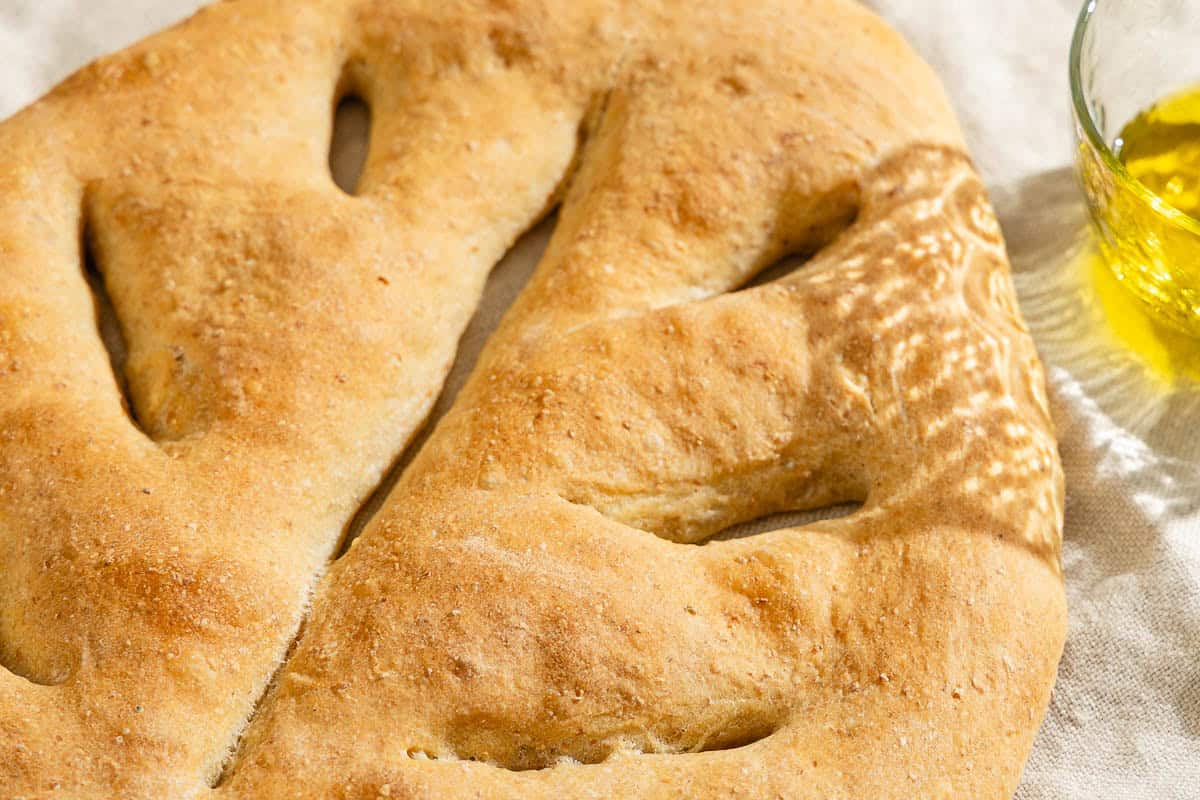
Make it Your Own
Because it’s rustic bread, all kinds of fougasse exist. You can find it with caramelized onions, olives, even bacon, or a sprinkling of cheese. Here are some of my favorite variations:
- Top with flaky salt: Just before baking, brush the fougasse lightly with olive oil and sprinkle some flaky salt over the top.
- Add herbs: In step 2, when mixing the dough, add 2 teaspoons of herbes de Provence.
- Add caramelized onion: In the last minute of kneading, add 1/2 to 3/4 cup of caramelized onion to the dough.
- Add garlic confit: In the last minute of kneading, add 1/2 cup of garlic confit, drained of its oil.
- Add olives: In the last minute of kneading, add 1/2 to 3/4 cup of roughly chopped pitted olives to the dough, such as Castelvetrano or Kalamata.
What to Serve with Fougasse
My favorite way to eat fougasse is also the simplest: tear it and dip it in olive oil, or even better, this olive oil bread dip with Parmesan and herbs. For an appetizer, put together a cheese plate with olives, almonds, and this creamy whipped feta dip. Or assemble a beautiful mezze platter for your next get-together.
With its higher ratio of chewy crust, fougasse is perfect for dipping in soups and stews. Pair it with another Provençal classic, ratatouille, for a comforting taste of southern France. For an even cozier meal, try this hearty chicken vegetable soup or this spiced and creamy pumpkin soup.
More Yeasted Mediterranean Breads
Browse all Mediterranean recipes.
Visit Our Shop.
Fougasse
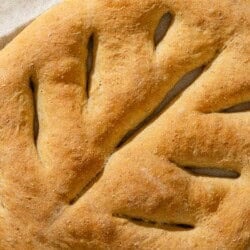
Ingredients
For the Poolish
- 1 cup bread flour (120g)
- 1/8 teaspoon instant yeast
- 1/2 cup water (120ml)
For the Fougasse
- poolish
- 1 1/2 cups bread flour (180g)
- 1/2 cup whole wheat flour (57g)
- 1/2 cup water (120ml)
- 1 teaspoon instant yeast
- 1 tablespoon extra virgin olive oil
- 1 teaspoon kosher salt
Instructions
- Make the poolish. In a medium bowl, combine the flour, yeast, and water. Cover the bowl and let it sit at room temperature overnight, or 12 to 16 hours. The poolish will be bubbly and should have at least doubled in size.
- Make the dough. In the bowl of a stand mixer fitted with the dough hook attachment, add all of the poolish, bread flour, whole wheat flour, water, yeast, olive oil, and salt. Mix on low speed until no dry streaks of flour remain. Then, knead the dough on medium speed (speed 2 on a KitchenAid mixer) for 5 minutes, until it becomes elastic and somewhat smooth.
- First rise. Shape the dough into a taut ball. Grease a clean bowl lightly with olive oil and place the ball of dough in the bowl seam-side down. Cover and leave it in a warm spot to rise for 1 hour.
- Lift and fold the dough. Wet your hands or coat them lightly with olive oil to prevent the dough from sticking. Grab a portion of dough at the top of the bowl. Gently stretch it upwards, and fold it over the center. Rotate the bowl 90 degrees and repeat until you’ve gone around the whole bowl, completing 4 folds. Flip the ball of dough so the seam side is underneath. Cover and leave it in a warm spot to rise for 1 hour longer.
- Shape the dough. Place a 14×16-inch piece of parchment paper on a work surface. Lightly grease the parchment paper with olive oil. Turn the dough out onto the parchment paper and shape it into a triangle about 12 inches long by 6 inches wide at the base. Let it rise for 30 minutes
- Slit the dough. Using a pizza wheel or a sharp knife, cut a slit down the center of the dough, stopping about 1 inch from each end. Then, make a few diagonal slits on each side of the center slit. Stretch each slit apart slightly, until they are about 2-inches wide, ensuring they stay separated after rising and baking. Let the dough rise for 30 minutes.
- Get ready to bake. While the dough is rising, place a baking stone on the middle shelf, and preheat the oven to 425°F.
- Bake the Fougasse. Using the parchment paper, carefully slide the fougasse onto a peel or the back of a sheet pan. Then, carefully slide the fougasse, along with the parchment paper, onto the baking stone. Bake the fougasse in the preheated oven for 25 to 30 minutes, or until it’s golden brown.
Notes
Nutrition
Build Your Own Spice Bundle
Stock your spice cabinet with the vibrant flavors of the Mediterranean. Buy 4 or more spices and save 5%. Buy 8 or more spices and save 8%!
